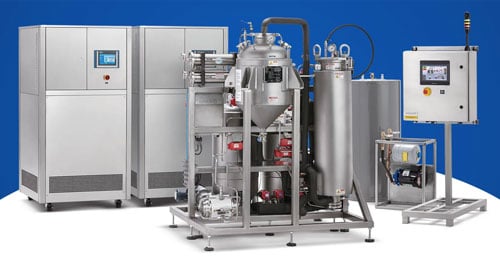For solvent-based extraction, BHO and Ethanol have emerged as the best methods to process most all types of cannabis biomass, from high-quality single-strain nugs to trim.
Maximize Profitability Through BHO and Ethanol Extraction
Cannabis Extraction: 10 Most Frequently Asked Questions
To keep up with the increased consumer demand for a wide variety of edibles, oils concentrate, and topicals, cannabis extraction technologies have grown by leaps and bounds in the past ten years. Fully automated solutions capable of producing high purity, potency, and flavor concentrate products at scale are not only the norm but a necessity for any extraction brands looking to dominate the marketplace.
Cannabinol (CBN) is a minor cannabinoid with significant therapeutic potential. However, only trace amounts of CBN are found in cannabis plants. Complex extraction methods using chemical solvents must be used to remove a high concentration of CBN from the plant material.
In today's highly competitive cannabis extraction market, processors must continuously improve operations and extraction efficiency. It is not enough to produce a high yield of cannabis resin. Now, operators should be able to extract as much of the THC content as possible.
15 Extraction Laboratory Safety Tips for Cannabis Laboratories
Cannabis extraction facilities can be a cauldron of potential hazards if a laboratory does not have the appropriate safety measures and systems put in place. From fire to explosions to asphyxiation, the dangers lurking in extraction labs are many.
Cannabis Extraction Safety: Safety Tips for Lab Facilities
In today's growing cannabis extraction segment, workplace safety is always top of mind. Licensed operators must meet strict building, equipment, and fire codes to reduce the risk of injury to workers and consumers alike.
In today's green rush, modern-day alchemists are pushing the envelope of the cannabis extraction process. No longer is cannabis flower king. Now, processors have whet consumer appetite with a wide range of concentrate-derived products.
In the fast-growing cannabis extraction segment, cannabis extracts can be produced through various extraction methods. Each cannabis processing method can produce cannabis oil full of cannabinoids, terpenes, and other essential compounds, known for their therapeutic effects.
Ethanol vs. CO2 vs. BHO for Cannabis and Hemp Extraction
The battle of the titans: ethanol extraction vs. BHO extraction vs. CO2 extraction. Which one produces the best cannabis oil? Which one is the best and most cost-effective method for cannabis producers? In short, it depends.
Light hydrocarbon solvents (butane and propane) have been the powerful, nonpolar compounds favored by the upper echelon of artisan edible makers.
From the colorful, sugar-frosted gummies to the rich and decadent fudge brownies cheekily laced with cannabinoids, these infused edibles are used for their therapeutic, and often, intoxicating effects.
For home amateurs, an easy ISO quick-wash can produce a rudimentary and solvent-free extract without blowing up the house. For commercial extraction, butane and propane extraction for concentrates provide the highest possible quality, purity, and throughput.


